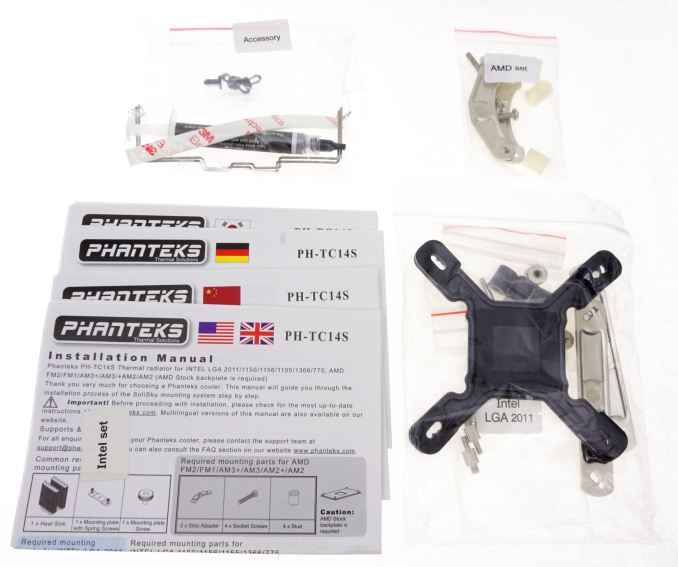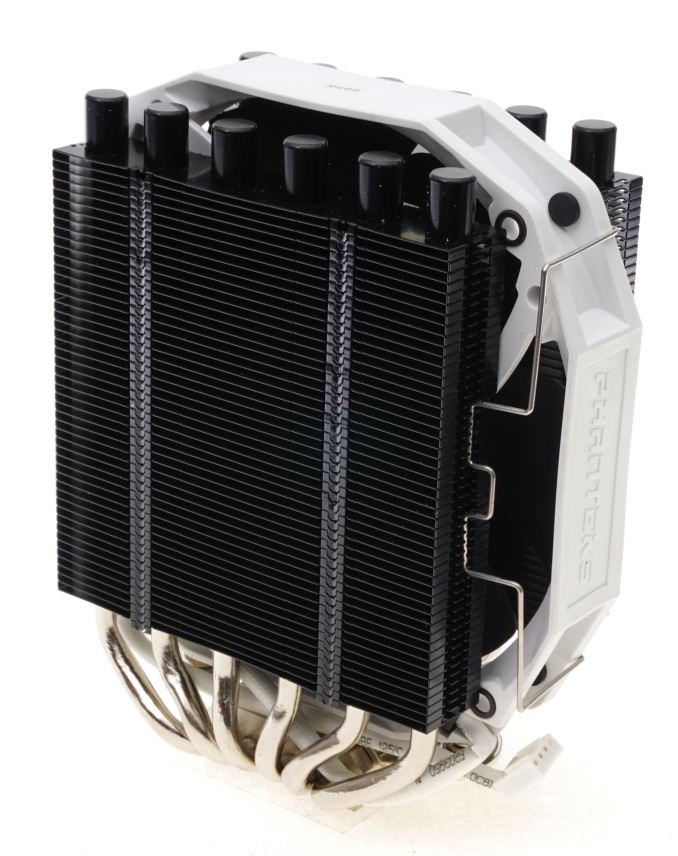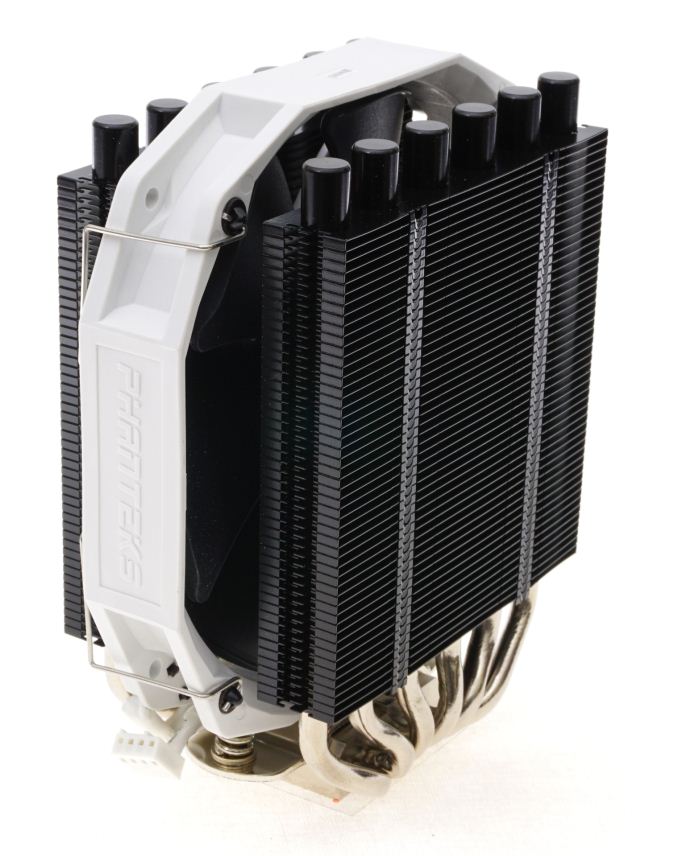The 140mm Slim Tower CPU Cooler Roundup: Thin & Light Done Just Right
by E. Fylladitakis on May 24, 2017 8:00 AM EST- Posted in
- Cases/Cooling/PSUs
- be quiet!
- Noctua
- Phanteks
- Cooler
- Thermalright
Phanteks PH-TC14S
Phanteks supplies the PH-TC14S inside a dark cardboard box with an abstract aesthetic theme, mostly based on schematic drawings of the cooler itself. It is not a very large box for a cooler that size, but it is very sturdy and the cooler is protected with polystyrene foam packaging, making it nearly impossible to damage during transport.
Inside the box we found four manuals, one for each of the most popular languages in the regions that the cooler is being marketed into, the necessary mounting hardware and a syringe with Phanteks PH-NDC thermal compound that should last for at least a couple of applications.
The Phanteks PH-TC14S is the “cheater” of this review, as it is not a single tower but a dual tower cooler design. It technically is a baby version of the monstrous PH-TC14PE that we had a look at a couple of years back. Still, this is Phanteks' only slim 140 mm tower cooler offering, and it is of comparable size to every other cooler in this roundup review. What the designers of Phanteks did was to split the single tower array into two very narrow arrays and place the 140 mm fan in between them. Strangely, the fins are significantly smaller than the fan without any apparent reason, meaning that there will be a significant loss of airflow to every direction.
The array fins are very thin and not strong individually, but they are soldered on the thick heatpipes that are only a few millimeters apart from each other. One major feature of the PH-TC14S is its black fins. Phanteks calls this paint job "Physical Antioxidant Thermal Shield" (or Physical Antioxidant Thermal Spraying - we found both in the company's texts) and claims that it enhances thermal performance by both increasing the dissipation rate of the heatsink itself and decreasing the radiation absorption rate from other heat sources. Unlike the PH-TC14PE, the PH-TC14S is available only in black.
The PH-F140HP fan also is a primary marketing focus of this product. It has the lowest RPM rating of every fan in this review (1300 RPM) but impressively high static pressure specifications (1.64 mm H2O at max speed).
Six thick heatpipes expand to either side of the small base. With the fin arrays placed in parallel, each heatpipe enters both arrays. Although that design appears very symmetric and effective at first, it actually does not appear to be optimal, as the two middle heatpipes that will be right above the CPU core and will be facing the bulk of the heat transfer enter near the fin arrays near the middle, where the fan’s airflow will be the lowest due to the dead spot under its motor.
The rectangular copper base of the PH-TC14S and the copper heatpipes are all nickel plated. Like with the majority of modern coolers, the base of the PH-TC14S is made of two parts, a copper contact plate and an aluminum top frame. The lower half of the base handles the thermal energy transfer away from the CPU and to the heatpipes, while the top half only offers mechanical cohesion and support for the steel mounting brackets. The nickel plated base is very smooth and machined down to a near-perfect mirror finish.
















74 Comments
View All Comments
JoeyJoJo123 - Wednesday, May 24, 2017 - link
For online comments, there's shills, then there is everyone else. Shills which are just trying to spread around this meme that X company's products are the best thing sliced bread.Just buy whatever you want, regardless what anyone else thinks. Don't pay brands any particular attention, just buy the best product you can for the best price you can and pocket your savings.
mgilbert - Wednesday, May 24, 2017 - link
Nice, mature response, with the name calling and all. Grow up, then read the actual review. The reviewer said the same thing I did. Now, go read a few more reviews of coolers, and you'll find that virtually all of them agree with this review. Noctua is expensive, but worth it. Generally I agree with you - it doesn't pay to go by brand name - but there are exceptions, and Noctua is one of them.close - Wednesday, May 24, 2017 - link
Noctua also costs a lot more than the competition. So when you're adding 35% to the price tag of any of the other products tested then you usually expect better performance (not mandatory though). So drawing the conclusion that Noctua is king of the hill in general isn't that useful.So... there are expensive products, then there are cheaper products :). For some people 35% markup might not be worth the extra performance.
WinterCharm - Thursday, May 25, 2017 - link
So? If you want the best you often have to pay more for it.The "best" is the best.
If you want the "best within a price bracket" THEN you can finagle and weigh things against each other.
JoeyJoJo123 - Wednesday, May 24, 2017 - link
Does Noctua pay you in stock, dividends, or a salary to promote their products online? If not, why do you go out of your way to promote free advertising to another company who you owe nothing to? You made your trade; your money for their product, there's no stipulation that you have to continue to sing praises for their company for other people to be more negotiable to give that same company more money for more products.Likewise, if you're upset about being called out on literal shilling, then it's really you that needs to grow up.
Additionally, the performance roundup review written by E. Fylladitakis doesn't have anything in common with your post, which you attribute as stating that "(t)he reviewer said the same thing I did". Fylladitakis makes no catch-all branding statement. They evaluate the four products, they make the measurements, they compare the measurements, then make a conclusion about the products based on the measurements.
YOU, however, are making a blanket statement about all performance CPU cooling products developed by Noctua being "superior in virtually every respects, especially quality and support."
Those statements can't be anymore unalike in any way. The former was a controlled experiment to evaluate product performance followed by an analysis of the products, the latter (your comment) is an opinion; void of any metric of data or analysis.
If you look at the thermal performance in this roundup, it shows that the Thermalright cooler (at $47, the cheapest of the four measured in this roundup) to have the best thermal performance at low temperature loads (where most performance PCs, the target audience of these $50 tower cooling solutions, stay outside of gaming or benchmark loads), theorized by Fylladitakis to be due to the direct contact design of the heatpipes, and a close-second (literally 16.6 vs 16.8 degrees Celsius delta over ambient, figures well within a margin of error of measurement) at 150W loads (where most overclocked mainstream CPUs will sit at full load), and still competes closely at completely unrealistic synthetic 340W loads.
So given a $47 price for the Thermalright vs $65 price for the Noctua, given similar performance figures, it's pretty apparent which has the better value for mainstream performance PCs.
Ryan Smith - Wednesday, May 24, 2017 - link
I love a vigorous discussion, but you guys need to cool it, please. There is no place for profanity here on AnandTech.mgilbert - Wednesday, May 24, 2017 - link
Yet, my post gets deleted, but not his, despite its divisive, hateful, argumentative, obtuse, disrespectful, inappropriate nature. Sounds like four letter words aren't the only thing not allowed on Anandtech. Fairness has no place, either.Ryan Smith - Wednesday, May 24, 2017 - link
I have made my ruling. I give you guys exceptional leeway as I believe you need to be free to discuss technical matters, but I draw the line at profanity and pointless ranting. You guys are done, please move on.If you wish to discuss it in private please email me.
fanofanand - Thursday, May 25, 2017 - link
We love you Ryan! Even when we complain, whine and moan about x, y, or z not being tested the specific way WE would do it, we love you!Ruh-roh, now I"m shilling for Anandtech! Don't worry, my username checks out.
JackNSally - Wednesday, May 24, 2017 - link
I have to agree, Noctua is the best. I do recommend the Hyper 212 for budget builds though.